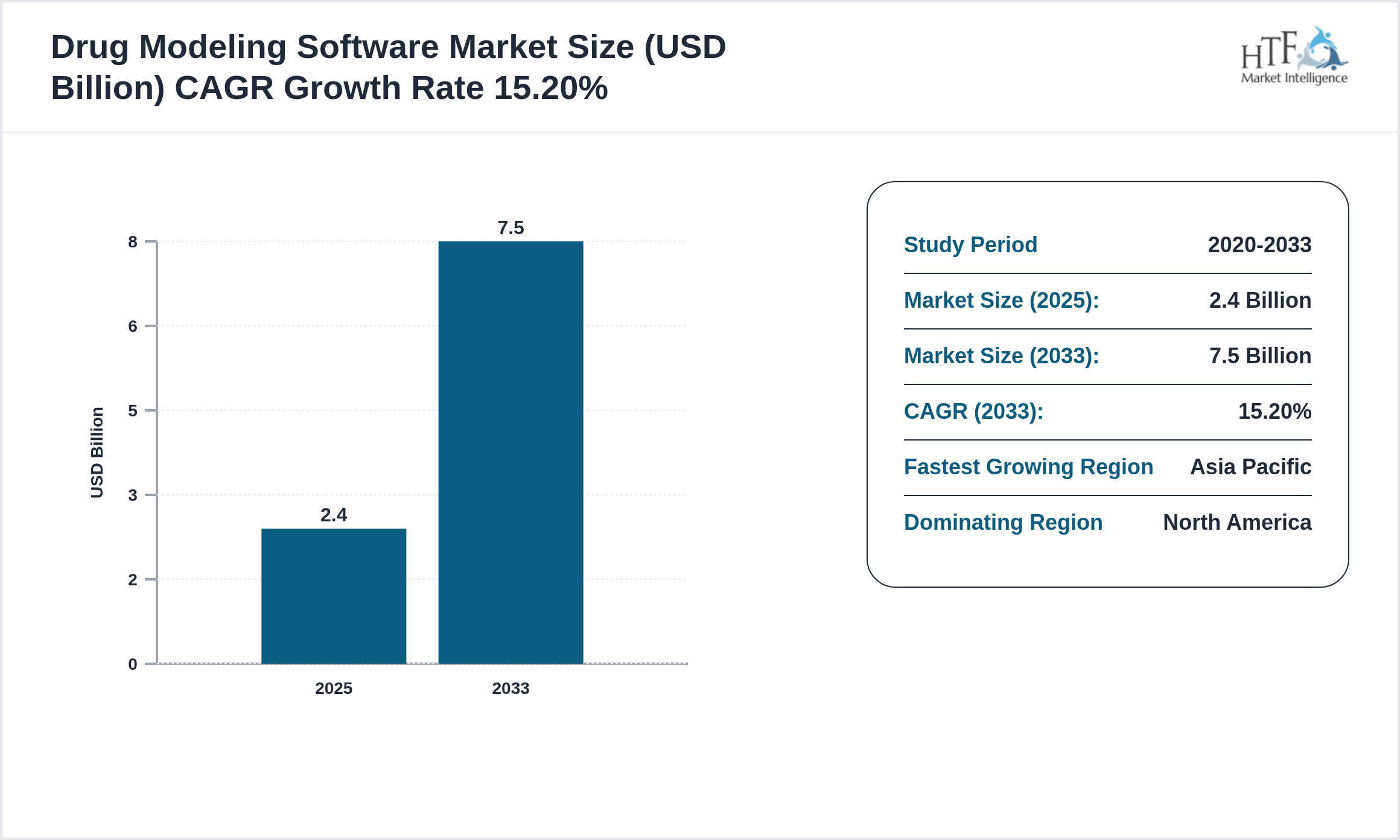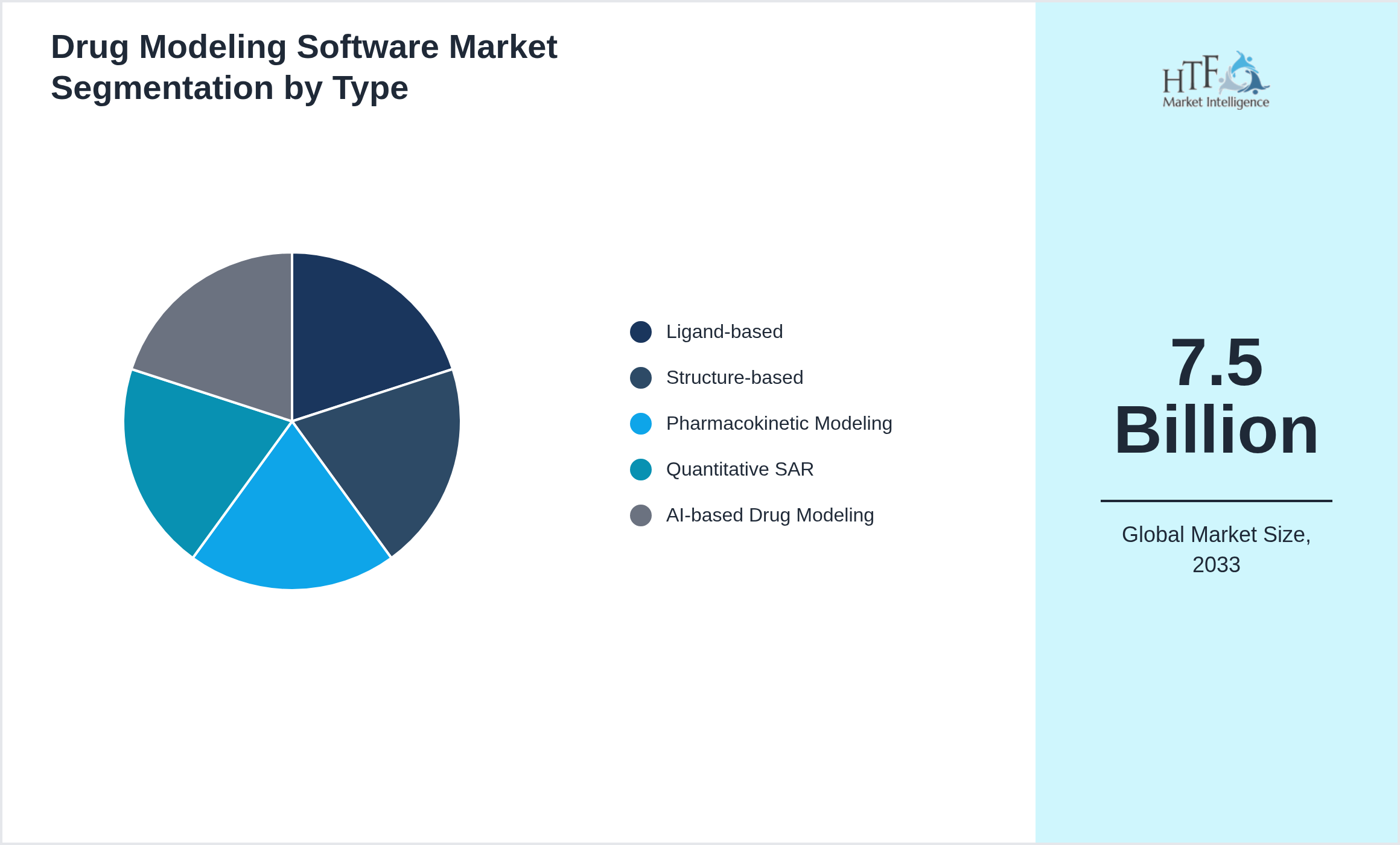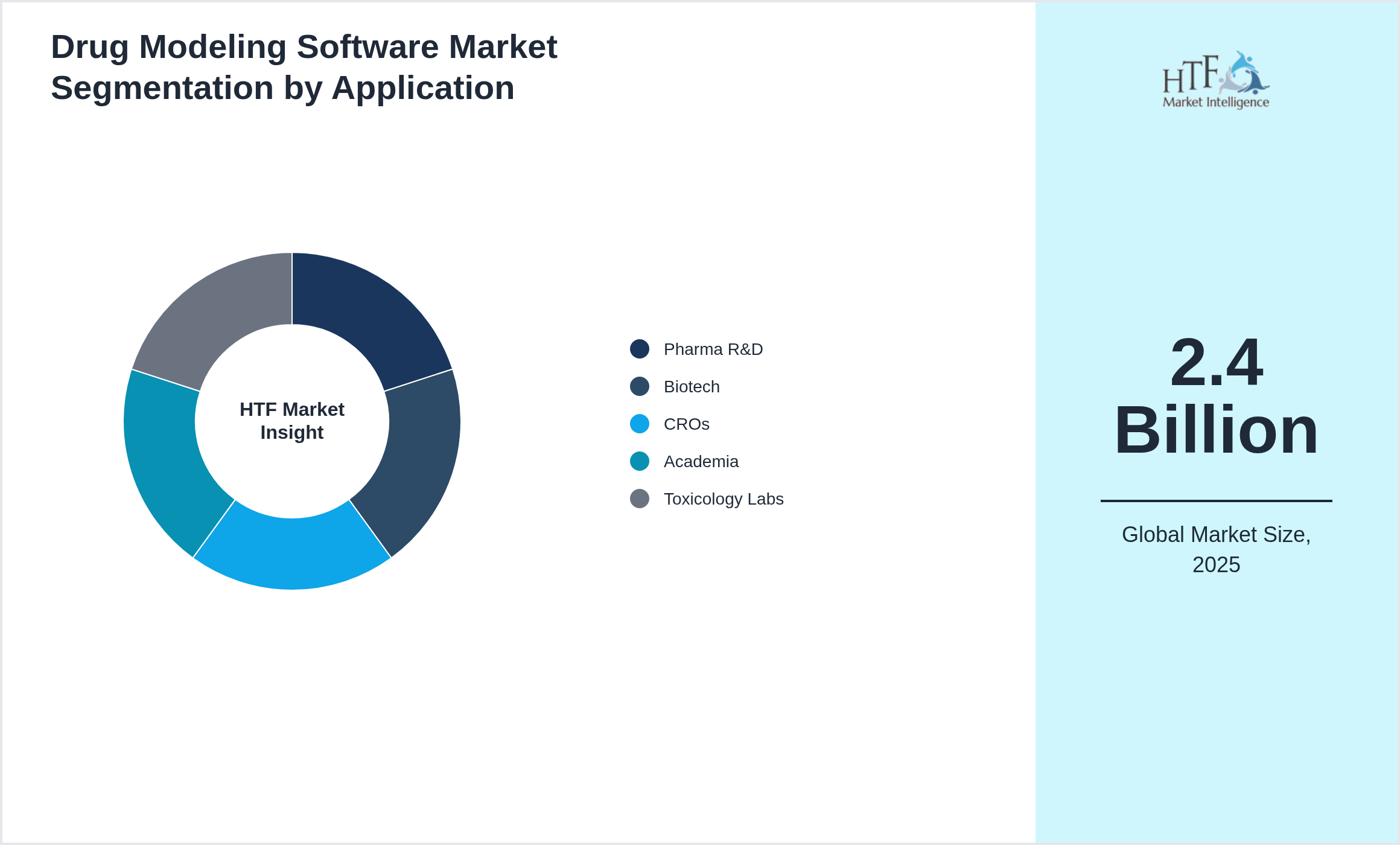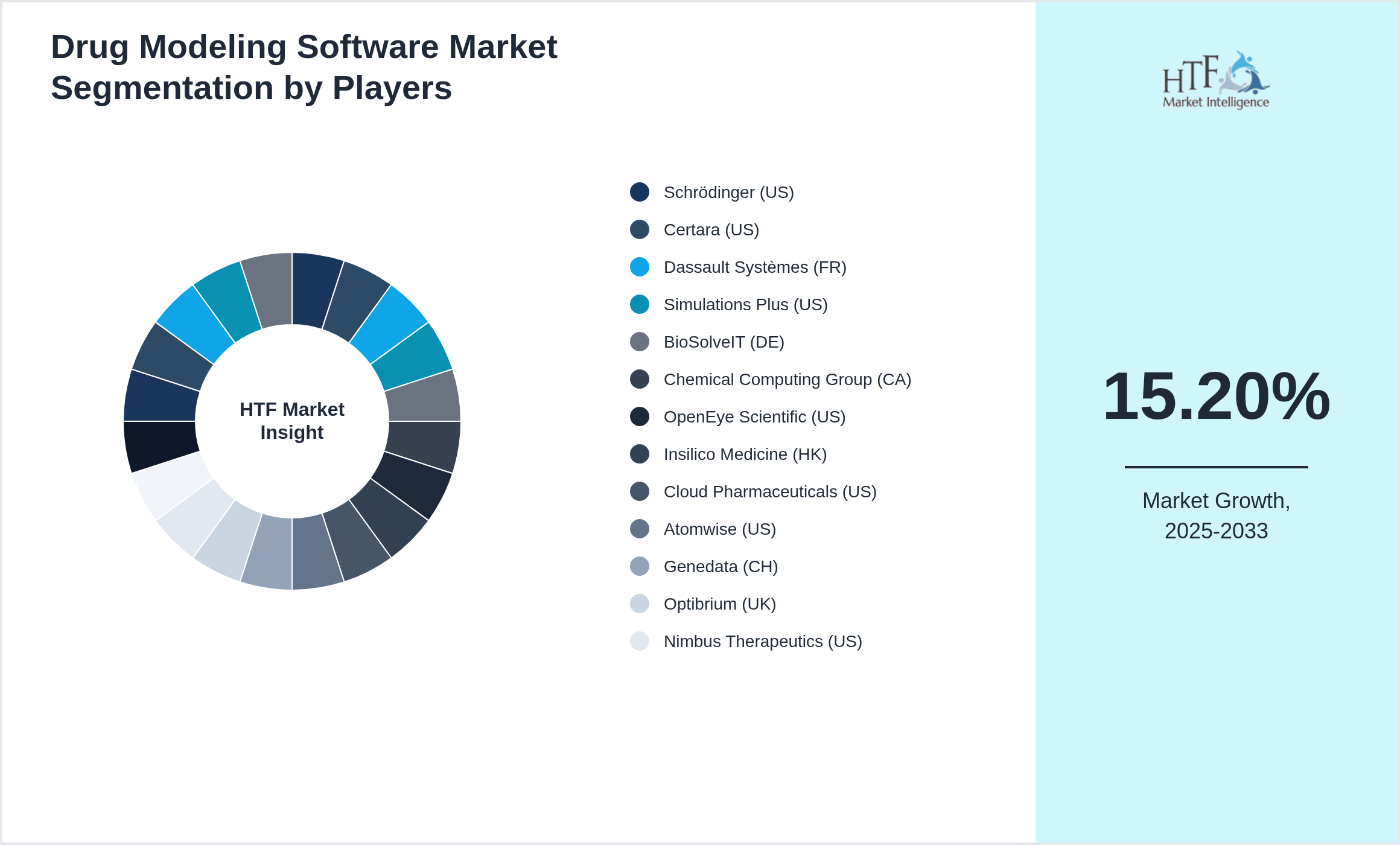Drug Modeling Software Market Research Report
Global Drug Modeling Software Market Roadmap to 2033
Global Drug Modeling Software Market is segmented by Application (Pharma R&D, Biotech, CROs, Academia, Toxicology Labs), Type (Ligand-based, Structure-based, Pharmacokinetic Modeling, Quantitative SAR, AI-based Drug Modeling), and Geography (North America, LATAM, West Europe, Central & Eastern Europe, Northern Europe, Southern Europe, East Asia, Southeast Asia, South Asia, Central Asia, Oceania, MEA)
Pricing
INDUSTRY OVERVIEW
The Drug Modeling Software market is experiencing robust growth, projected to achieve a compound annual growth rate CAGR of 15.20% during the forecast period. Valued at 2.4 Billion, the market is expected to reach 7.5 Billion by 2033, with a year-on-year growth rate of 6.30%. This upward trajectory is driven by factors such as evolving consumer preferences, technological advancements, and increased investment in innovation, positioning the market for significant expansion in the coming years. Companies should strategically focus on enhancing their offerings and exploring new market opportunities to capitalize on this growth potential.

Drug modeling software enables virtual simulation of molecular behavior, structure-activity relationships (SAR), and pharmacokinetic parameters during drug discovery and development. These platforms allow researchers to predict drug-target interactions, toxicity, and metabolism, minimizing the need for physical screening and accelerating R&D timelines. They employ techniques like QSAR, molecular docking, and pharmacophore modeling. The market is driven by the surge in AI-based drug discovery, pharma digitalization, and the growing demand for repurposing drugs quickly. Cloud-based and SaaS offerings are making these tools more accessible to biotech startups and CROs. With a growing focus on rare diseases and precision therapies, computational drug modeling is emerging as a central pillar in pharmaceutical research.
Regulatory Landscape
- • Regulatory bodies like FDA and EMA are exploring guidance for in-silico trials and simulation-validated drug discovery. Simulations are now used to supplement or accelerate preclinical evaluation.
Regulatory Framework
The Information and Communications Technology (ICT) industry is primarily regulated by the Federal Communications Commission (FCC) in the United States, along with other national and international regulatory bodies. The FCC oversees the allocation of spectrum, ensures compliance with telecommunications laws, and fosters fair competition within the sector. It also establishes guidelines for data privacy, cybersecurity, and service accessibility, which are crucial for maintaining industry standards and protecting consumer interests.
Globally, various regulatory agencies, such as the European Telecommunications Standards Institute (ETSI) and the International Telecommunication Union (ITU), play significant roles in standardizing practices and facilitating international cooperation. These bodies work together to create a cohesive regulatory framework that addresses emerging technologies, cross-border data flow, and infrastructure development. Their regulations aim to ensure the ICT industry's growth is both innovative and compliant with global standards, promoting a secure and competitive market environment.
Key Highlights
• The Drug Modeling Software is growing at a CAGR of 15.20% during the forecasted period of 2020 to 2033
• Year on Year growth for the market is 6.30%
• Based on type, the market is bifurcated into Ligand-based, Structure-based, Pharmacokinetic Modeling, Quantitative SAR, AI-based Drug Modeling
• Based on application, the market is segmented into Pharma R&D, Biotech, CROs, Academia, Toxicology Labs
• Global Import Export in terms of K Tons, K Units, and Metric Tons will be provided if Applicable based on industry best practice
Market Segmentation Analysis
Segmentation by Type
- • Ligand-based
- • Structure-based
- • Pharmacokinetic Modeling
- • Quantitative SAR
- • AI-based Drug Modeling

Segmentation by Application
- • Pharma R&D
- • Biotech
- • CROs
- • Academia
- • Toxicology Labs

Key Players
Several key players in the Drug Modeling Software market are strategically focusing on expanding their operations in developing regions to capture a larger market share, particularly as the year-on-year growth rate for the market stands at 6.30%. The companies featured in this profile were selected based on insights from primary experts, evaluating their market penetration, product offerings, and geographical reach. By targeting emerging markets, these companies aim to leverage new opportunities, enhance their competitive advantage, and drive revenue growth. This approach not only aligns with their overall business objectives but also positions them to respond effectively to the evolving demands of consumers in these regions.
- • Schrödinger (US)
- • Certara (US)
- • Dassault Systèmes (FR)
- • Simulations Plus (US)
- • BioSolveIT (DE)
- • Chemical Computing Group (CA)
- • OpenEye Scientific (US)
- • Insilico Medicine (HK)
- • Cloud Pharmaceuticals (US)
- • Atomwise (US)
- • Genedata (CH)
- • Optibrium (UK)
- • Nimbus Therapeutics (US)
- • ChemAxon (HU)
- • Cyclica (CA)
- • Lead Molecular Design (JP)
- • Rasa Life Science (IN)
- • Pharmacelera (ES)
- • e-therapeutics (UK)
- • Enamine (UA)

Research Methodology
At HTF Market Intelligence, we pride ourselves on delivering comprehensive market research that combines both secondary and primary methodologies. Our secondary research involves rigorous analysis of existing data sources, such as industry reports, market databases, and competitive landscapes, to provide a robust foundation of market knowledge. This is complemented by our primary research services, where we gather firsthand data through surveys, interviews, and focus groups tailored specifically to your business needs. By integrating these approaches, we offer a thorough understanding of market trends, consumer behavior, and competitive dynamics, enabling you to make well-informed strategic decisions. We would welcome the opportunity to discuss how our research expertise can support your business objectives.
Market Dynamics
Market dynamics refer to the forces that influence the supply and demand of products and services within a market. These forces include factors such as consumer preferences, technological advancements, regulatory changes, economic conditions, and competitive actions. Understanding market dynamics is crucial for businesses as it helps them anticipate changes, identify opportunities, and mitigate risks.
By analyzing market dynamics, companies can better understand market trends, predict potential shifts, and develop strategic responses. This analysis enables businesses to align their product offerings, pricing strategies, and marketing efforts with evolving market conditions, ultimately leading to more informed decision-making and a stronger competitive position in the marketplace.
Market Driver
- • Rising drug discovery demand
- • cost-effective virtual screening
- • growing AI adoption
- • integration with omics data
- • surge in rare disease focus.
Market Trend
- • Cloud-based simulations
- • ML-driven molecule screening
- • integrated ADMET profiling
- • open-source modeling tools
- • high-throughput docking workflows.
- • Precision medicine growth
- • AI+ML convergence
- • academic-industry partnerships
- • SaaS deployment
- • orphan drug model acceleration.
Challenge
- • High software licensing cost
- • complexity in data input
- • limited datasets for novel targets
- • regulatory validation barriers
- • integration challenges with legacy systems.
Regional Analysis
- • The US dominates with active biotech and pharma sectors. Europe supports through Horizon funding and academic tie-ups. China is rapidly scaling its computational biology capabilities with national investment in bioinformatics.
- • In September 2023
- • July 2025: Certara acquired MolSimTech to expand AI-based pharmacokinetic and molecular simulation capabilities in early-stage drug discovery.
- • Regulatory bodies like FDA and EMA are exploring guidance for in-silico trials and simulation-validated drug discovery. Simulations are now used to supplement or accelerate preclinical evaluation.
- • Patents focus on multi-target docking algorithms
- • VC firms are heavily funding drug discovery AI platforms. Strategic investments from big pharma aim to integrate computational modeling to lower their development costs and risks.
Regional Outlook
The North America Region holds the largest market share in 2025 and is expected to grow at a good CAGR. The Asia Pacific Region is the fastest-growing region due to increasing development and disposable income.
North America remains a leader, driven by innovation hubs like Silicon Valley and a strong demand for advanced technologies such as AI and cloud computing. Europe is characterized by robust regulatory frameworks and significant investments in digital transformation across sectors. Asia-Pacific is experiencing rapid growth, led by major markets like China and India, where increasing digital adoption and governmental initiatives are propelling ICT advancements.
The Middle East and Africa are witnessing steady expansion, driven by infrastructure development and growing internet penetration. Latin America and South America present emerging opportunities, with rising investments in digital infrastructure, though challenges like economic instability can impact growth. These regional differences highlight the need for tailored strategies in the global ICT market.
- North America
- LATAM
- West Europe
- Central & Eastern Europe
- Northern Europe
- Southern Europe
- East Asia
- Southeast Asia
- South Asia
- Central Asia
- Oceania
- MEA
|
Report Features |
Details |
|
Base Year |
2025 |
|
Based Year Market Size (2025) |
2.4 Billion |
|
Historical Period Market Size (2020) |
USD Million ZZ |
|
CAGR (2025 to 2033) |
15.20% |
|
Forecast Period |
2025 to 2033 |
|
Forecasted Period Market Size (2033) |
7.5 Billion |
|
Scope of the Report |
Ligand-based, Structure-based, Pharmacokinetic Modeling, Quantitative SAR, AI-based Drug Modeling, Pharma R&D, Biotech, CROs, Academia, Toxicology Labs |
|
Regions Covered |
North America, Europe, Asia Pacific, South America, and MEA |
|
Year on Year Growth |
6.30% |
|
Companies Covered |
Schrödinger (US), Certara (US), Dassault Systèmes (FR), Simulations Plus (US), BioSolveIT (DE), Chemical Computing Group (CA), OpenEye Scientific (US), Insilico Medicine (HK), Cloud Pharmaceuticals (US), Atomwise (US), Genedata (CH), Optibrium (UK), Nimbus Therapeutics (US), ChemAxon (HU), Cyclica (CA), Lead Molecular Design (JP), Rasa Life Science (IN), Pharmacelera (ES), e-therapeutics (UK), Enamine (UA) |
|
Customization Scope |
15% Free Customization (For EG) |
|
Delivery Format |
PDF and Excel through Email |
Drug Modeling Software - Table of Contents
Chapter 1: Market Preface
Chapter 2: Strategic Overview
Chapter 3: Global Drug Modeling Software Market Business Environment & Changing Dynamics
Chapter 4: Global Drug Modeling Software Industry Factors Assessment
Chapter 5: Drug Modeling Software : Competition Benchmarking & Performance Evaluation
Chapter 6: Global Drug Modeling Software Market: Company Profiles
Chapter 7: Global Drug Modeling Software by Type & Application (2020-2033)
Chapter 8: North America Drug Modeling Software Market Breakdown by Country, Type & Application
Chapter 9: Europe Drug Modeling Software Market Breakdown by Country, Type & Application
Chapter 10: Asia Pacific Drug Modeling Software Market Breakdown by Country, Type & Application
Chapter 11: Latin America Drug Modeling Software Market Breakdown by Country, Type & Application
Chapter 12: Middle East & Africa Drug Modeling Software Market Breakdown by Country, Type & Application
Chapter 13: Research Finding and Conclusion
Frequently Asked Questions (FAQ):
The Compact Track Loaders market is expected to see value worth 5.3 Billion in 2025.
North America currently leads the market with approximately 45% market share, followed by Europe at 28% and Asia-Pacific at 22%. The remaining regions account for 5% of the global market.
Key growth drivers include increasing construction activities, rising demand for versatile equipment in agriculture, technological advancements in track loader design, and growing preference for compact equipment in urban construction projects.
